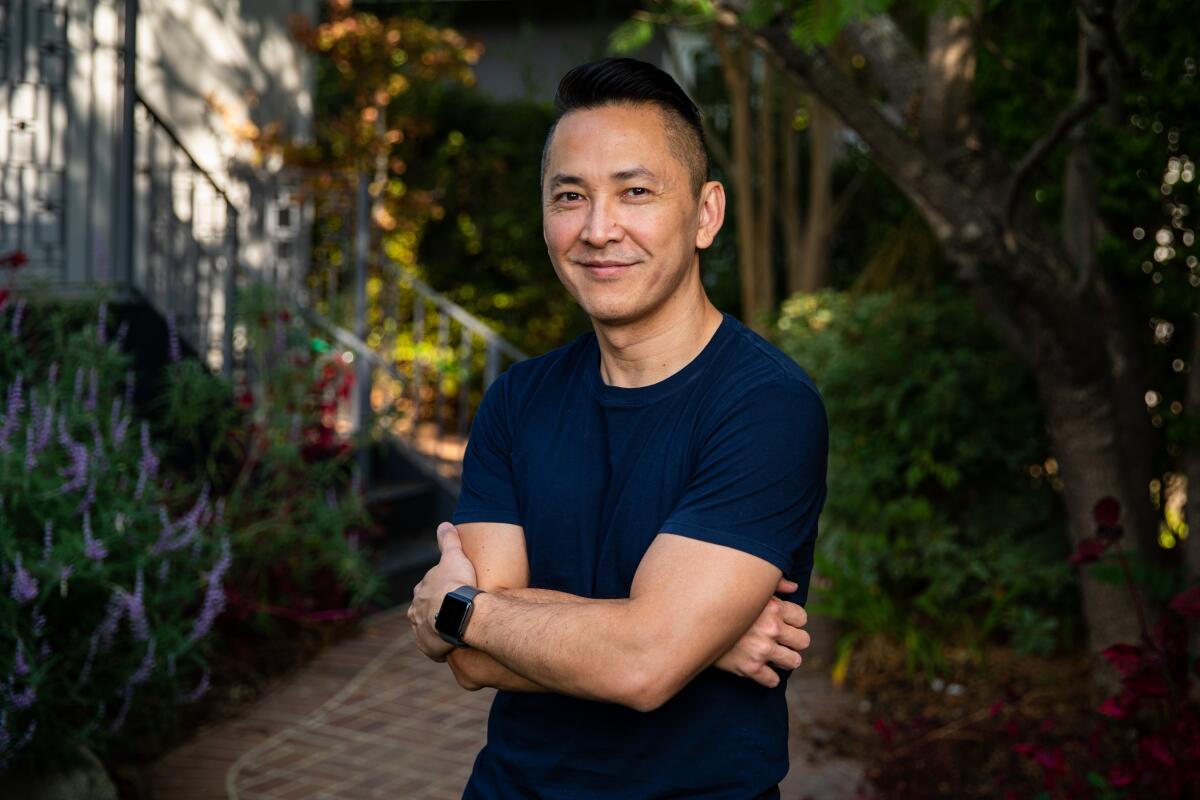Essential Arts: Juergen Teller and the unglamorous history of anti-fashion photography

Welcome to the weekend. I’m Carolina A. Miranda, arts and urban design columnist at the Los Angeles Times, and I am baaaaaaack. Thanks to my colleagues for holding down the newsletter fort while I spent two weeks in a pandemic resort of my own making, which consisted of generally not moving while reading novels, watching movies and dipping into the wide selection of liquor options that now come in adorable little cans. I’m here for the design of Tozai’s “Night Swim” sake.
The Juergen Teller internet hoo-ha
My kid could do that.
A version of that age-old debate cropped up on social media last week when W Magazine unveiled its annual “Best Performances” portfolio featuring George Clooney, Riz Ahmed, LaKeith Stainfield and many other stars photographed by Juergen Teller on the streets of Los Angeles.
The reaction to Teller’s images — bereft of fancy lighting and featuring stars casually hanging out in shopping carts, lounging on sidewalks and perched in trees — was immediate.
“Why do these pictures look like a middle school girl took them with her friends by the 7/11 just so she could upload them to a facebook album called ‘~*SuMmEr AdVeNtUrEs *~,” tweeted writer Dana Schwartz.
“THERES A WHOLE LOT OF THIS LACK OF EFFORT,” chimed in a Twitter user who goes by Apostrophie.
Other users went on to post their own parody images: taking unartful photos of themselves and attributing them to Teller. (Artnet has helpfully rounded up the reactions.)
This is not the first controversy sparked by the German-born photographer, who is based in London. A 2015 shoot featuring Kim Kardashian and Kanye West for System magazine posing amid construction equipment was not well-received. Two years ago Teller again set the internet afire when Vogue published a series of portraits that appeared to borrow heavily from the work of artist Mickalene Thomas.
For this shoot, however, Teller was doing what he has always done: strip the artifice from fashion to focus on something more visceral and immediate.
Certainly, he isn’t the first to do this. Fashion has long had a push-pull with reality. In the 1940s, artists such as Irving Penn, who tucked his subjects into corners and placed them on old ladders, functioned as a reaction against the over-the-top glamour of photographers like Cecil Beaton. In a 2020 essay for Aperture magazine, curator Lou Stoppard writes about the ways in which Nan Goldin, known for the gritty images of her 1980s New York milieu, was influenced by fashion photographers and influenced them in turn.
Teller is part of a generation of photographers who brought a documentary eye to fashion photography in the 1990s: shooting on abject street corners in the naked light of day, without filters or dramatic lighting. This included figures such as David Sims, Nigel Shafran and the late Corinne Day, who was known for her frank images of era punks and waifs.
Teller’s style has long included the use of overexposed light (he regularly deploys the glare of a camera flash in wildly unglamorous and unsparing ways) and is fond of scenarios that are infused with absurdity.
For one of his earliest series, known as the “Go-Sees,” Teller photographed models on the streets of London in street clothes and without makeup as if he had happened upon them. Other images from that era feature supermodels in highly unfashion-y poses — such as Kate Moss, in bed, surrounded by a halo of pink hair, looking as if she has been interrupted from going to sleep.
Make the most of L.A.
Get our guide to events and happenings in the SoCal arts scene. In your inbox once a week.
You may occasionally receive promotional content from the Los Angeles Times.
Teller’s later photographs are no more forgiving. A 2008 campaign for the fashion designer Marc Jacobs features Victoria Beckham, her legs emerging from a giant shopping bag — her face nowhere to be seen. A 2010 portrait of a saggy-eyed William Eggleston shows the photographer conducting along to Tchaikovsky, a lamp askew in the background, looking like your stern, too-formal uncle schooling you on classical music.
Teller has deployed this flash-filled gaze in far more risqué ways too, say, by depicting fashion designer Vivienne Westwood naked on a couch, her legs spread and a smirk on her face — a compelling portrait of a middle-aged woman who has no you-know-whats left to give.
And he isn’t afraid to turn his lens on himself. A series from 2004 shows the photographer, on his back, providing a proctologist’s view of his sphincter to the camera while Charlotte Rampling plays the piano in the background. (I’ll let you find those images on your own.)

Some of the internet debate around the W portfolio swirled around whether Teller might be pulling one over on us — a frequent criticism of Modern art. It also implied that Teller is somehow disrespecting his subjects by not glamorizing them more fully. Naomi Fry wrote about that phenomenon in the New Yorker, noting that what Teller is more likely disrespectful toward is “the very notion of stardom.”
Ironic, of course, given that Teller is now a celebrity himself, which makes that equation more complicated. As Louise Benson writes in an essay in Elephant, if W had wanted to be truly radical, they might have used the portfolio to diversify the magazine’s ranks of photographers.
In my mind, the controversy highlights the issue of context along with the flattening power of the internet. Teller’s images are intended to be seen in the context of a tony fashion magazine, introducing a lightning shot of reality amid the highly polished images of giant handbags and of-the-moment runway ensembles. On the internet, however, they become rather indistinguishable from the social media morass.
And in the middle of the pandemic, even more so: The Golden Globe Awards, full of grainy red carpet interviews done via Zoom, featuring pets and kids and unremarkable dens, may have out-Tellered Juergen Teller.
Not that Teller is out of ideas. A more intriguing series of pandemic images by the photographer ran last summer in System magazine. They feature images of actors, designers, artists and curators framed on an iPad that Teller has placed amid pieces of fruit and other random detritus. These read like part-analog, part-digital 21st-century still lifes.
They aren’t pretty. They’re not meant to be. Life, it turns out, is never like the pages of a fashion magazine.
Art and coronavirus
We are almost at the year mark in the pandemic and I’m still inserting that header into this newsletter. As I write this, U.S. deaths from COVID-19 stand at more than 517,000, and Los Angeles remains partly shuttered in one of the most restrictive pandemic tiers.
At this moment of taking account, Times theater critic Charles McNulty spoke with a group of stage workers — directors, playwrights, set designers and performers — to see how they are holding up after a year in which theater has remained in the dark. Collectively, they have navigated the pandemic with creativity, unemployment benefits, sheer wile and a streak of humor. “Like a lot of performers, we thought we’d never work again,” says Richard Montoya of theatrical troupe Culture Clash. “You get that last check, and you’re like, ‘I guess we’re going to clean pools! There’ll always be gardening work in Los Angeles!’”

In the meantime, culture writer Deborah Vankin is keeping a running list of museum openings in California at this link. Museums in San Francisco will begin to open this week; Los Angeles, not yet.
All of which raises the question of what exactly is happening with museums? On Friday, Gov. Gavin Newsom’s office announced that theme parks and sports stadiums — yes, you read that right — will be allowed to reopen (with certain limits) as early as April 1. Not mentioned anywhere in the order? Museums.
All of this raises the question, as I wrote late last month, about which industries have the power to lobby for looser restrictions and which do not. As I note in my story, museums are highly controlled, no-touch environments. And they are currently operating under a bizarre set of state rules that allow their retail outlets to remain open but are forced to keep their galleries under lock and key.
This, despite the fact that researchers at the Berlin Institute of Technology recently reported that the risk of COVID-19 transmission while visiting a museum is far lower than at other indoor activities. As Hakim Bishara writes in Hyperallergic, “The researchers found that if kept at 30% capacity with everyone wearing a mask and following proper precautions, museums, theaters, and operas are safer than any other activity studied.”
The only thing the plan highlights is that museums don’t have the lobbying muscles of Disney.
Enjoying this newsletter? Consider subscribing to the Los Angeles Times
Your support helps us deliver the news that matters most. Become a subscriber.
Elsewhere in corona-land, writer John Seabrook has an interesting piece in the New Yorker about how the pandemic is liable to shape office design.
A peep show, but make it high-brow: Here’s how one Japanese dance company is staging performances in the age of COVID-19.
Home again
The housing crisis has only become more acute as a result of the pandemic. Contributor Sam Lubell has a look at what the urban design nonprofit LA Más is doing about it. The Backyard Homes Project, as the initiative is titled, assists middle and low-income homeowners in the construction of ADUs — so-called “granny flats” — provided those units are made available to Section 8 tenants for a minimum of five years.
I have a look at the city of L.A.’s newly launched ADU Standard Plan Program, which has developed pre-approved designs by more than a dozen architectural studios based in SoCal and beyond to cut out permitting processes that can eat up money and time. The idea is to bring a little bit of high design to ADU construction while supporting the work of up-and-coming architectural firms at a time when the pandemic has hammered them financially. “Smaller types of construction,” says the city’s chief design officer, Christopher Hawthorne, “can be a lifeline for smaller firms.”

Art report
The Times’ Makeda Easter tells the story of Mary Chaney, the late courtroom artist who sketched the trials of the LAPD officers implicated in the beating of Rodney King in the early 1990s. Several years ago, her daughter Lark Ireland Snouffer had tried to place the collection of King-related images with the Library of Congress, but her offer was declined. Last year’s uprisings in support of Black lives, however, changed the equation. The Library is now acquiring 269 sketches related to King. “This particular collection,” says Snouffer, “is so important and so historical.”
Related: My colleague Julia Wick, who writes the Essential California newsletter, had a terrific piece about video technology and the role it has played in capturing police brutality against Black people. (Sign up for that newsletter here.)

Alabama artist Michelle Browder is building a monument in Montgomery to the enslaved women who served as subjects in the brutal surgical experiments of J. Marion Sims, the 19th century doctor credited as the “father of modern gynecology.” On Saturday morning, the artist will be in Venice Beach, where she will collect metal objects donated by the public to be employed as material in the piece.
“Discarded objects represent how Black women have been treated in this country,” she tells Deborah Vankin. “But it also represents the beauty that’s in the broken and the discarded.”
Times art critic Christopher Knight reviews photographer Mark McKnight‘s first solo at Park View / Paul Soto Gallery, featuring images of moody landscapes and entwined bodies. “McKnight deftly harnesses standard metaphors — the tree as home to the spirit, sanctuary of the soul; the landscape as an unsullied Eden set against a fraught humanity — and turns them to his own ends,” he writes. “He does the same with photographs focused on clouds in the sky: Big, fluffy volumes overhead are shot through with vaporous light. Yet, a storm also seems to be brewing, a looming heart of darkness within the ephemeral ether that intrudes on the possibility for getting lost in an idyllic summer daydream.”

Times culture writer Jessica Gelt reports how the coronavirus has shifted the work of photographer Jim Krantz, whose iconic commercial images of the West helped cement the idea of the Marlboro Man (images that have been famously appropriated by painter Richard Prince). With commercial shoots almost non-existent, Krantz has turned his lens on his Beachwood Canyon neighbors — including the likes of Diplo and author/screenwriter Tinker Lindsay. A show of his work is on view at Danziger Gallery in Santa Monica through April 3.
Plays and players
England’s Royal Shakespeare Company is getting into video games. Sort of. The theatrical company is using a video game engine to create “Dream,” a 50-minute interactive work that is part theater, part game, and which allows the audience to participate and collaboratively guide the story inspired by “A Midsummer Night’s Dream.” As game critic Todd Martens writes, it’s the kind of development that will likely “long outlive the COVID-19 era.”

Essential happenings
Matt Cooper has the lowdown on 20 weekend culture picks, including the latest of the L.A. Phil‘s socially distanced concert series and Herbert Siguenza’s one-man show, “A Weekend with Picasso.”
Next Wednesday, I’ll be hosting The Times’ Book Club, interviewing novelist Viet Thanh Nguyen about his new novel “The Committed,” the highly anticipated follow-up to his Pulitzer-winning “The Sympathizer.” As contributor Agatha French notes, the book contains “gangsters, drug dealing, turf wars and shootouts” — alongside some unorthodox dialogues about colonialism and racism. This should be a super fun convo. Get all the deets here.

Passages
Toko Shinoda, a Japanese artist whose work fused calligraphy and Abstract Expressionism in elegant ways, is dead at 107.
Fred Segal, the fashion retailer who helped define L.A.’s casual style and cultivated in the public a taste for high-brow denim, has died at the age of 87. In a tribute to Segal, Times fashion scribe Adam Tschorn remembers the “rock-star retailer known far beyond his centers’ iconic ivy-covered walls.”

Hugh Newell Jacobsen, the D.C.-based architect who made the simple gabled house something sculptural, and oversaw additions or restorations at the U.S. Capitol and two Smithsonian museums, is dead at 91 from complications related to COVID-19.
Naomi Rosenblum, a New York scholar who helped elevate photography as an art form and put it in a global context in essential books such as “A World History of Photography,” has died at 96.
Bill C. Davis, who explored Catholic orthodoxies in wry ways in plays such as the Tony-nominated “Mass Appeal,” is dead at 69.
In other news
— Silas Farley, an alum of New York City Ballet who has performed principal roles in works by George Balanchine and Christopher Wheeldon, has been named dean of the Colburn School’s Trudl Zipper Dance Institute.
— President Biden has revoked Trump’s executive order that mandated Neoclassical architecture for most federal buildings.
— As lavish director perks come under fire (see: the case of the Brooklyn Academy of Music this week), the Baltimore Museum of Art and the Walters Art Museum in Maryland have raised the wages of their lowest-paid employees to $15 an hour.
— Architecture writer Mimi Zeiger says it may be time to abolish the architecture critic.
— Damages and other costs related to the U.S. Capitol during the Jan. 6 riot will exceed $30 million, says architect of the capitol J. Brett Blanton.
— Hunter S. Thompson ran for sheriff in Colorado in 1970. A new show in New York titled “Freak Power” pulls together his campaign’s no-holds-barred graphic design.
— A brief history of the L.A. house gallery.
— “It requires an emphatic self-naming and assertive space-claiming.” Essayist Lynell George on what it means to be Black in L.A.
And last but not least ...
How are you staying sane as the pandemic turns a year old? Send me your culture recipe by hitting reply to this email. Mine is a mix of novel reading (Ling Ma’s prescient “Severance” had me rapt) as well as books about Italian futurism and the architecture of Gio Ponti (his buildings are on my itinerary the moment I can safely hop a flight to Italy), all of it blended with plenty of yoga. I’m loving Chris Reed’s regular Friday Zoom class for Jivamukti on Union.fit, which features his pitbull, Clementine. <3<3<3
The biggest entertainment stories
Get our big stories about Hollywood, film, television, music, arts, culture and more right in your inbox as soon as they publish.
You may occasionally receive promotional content from the Los Angeles Times.




